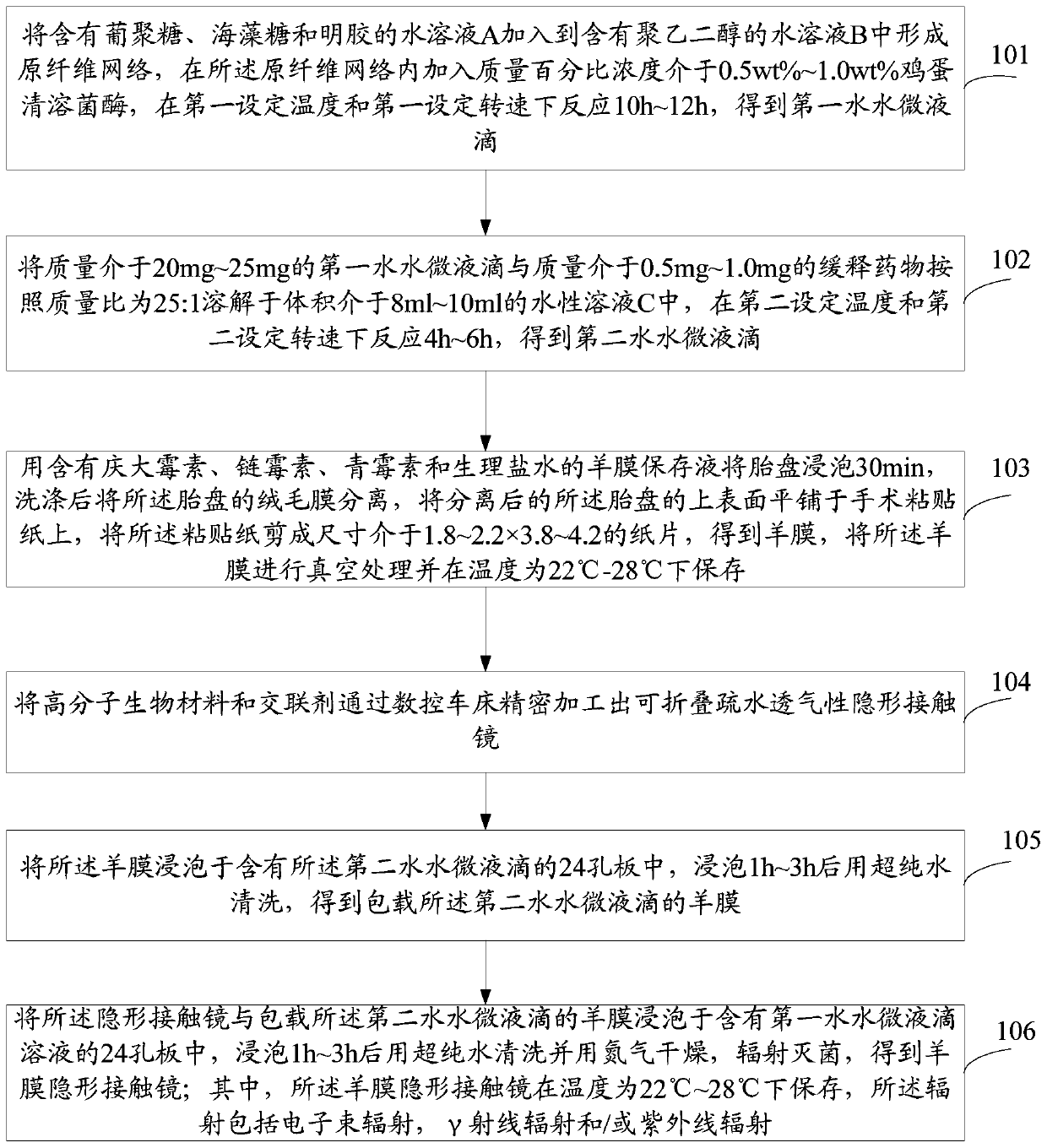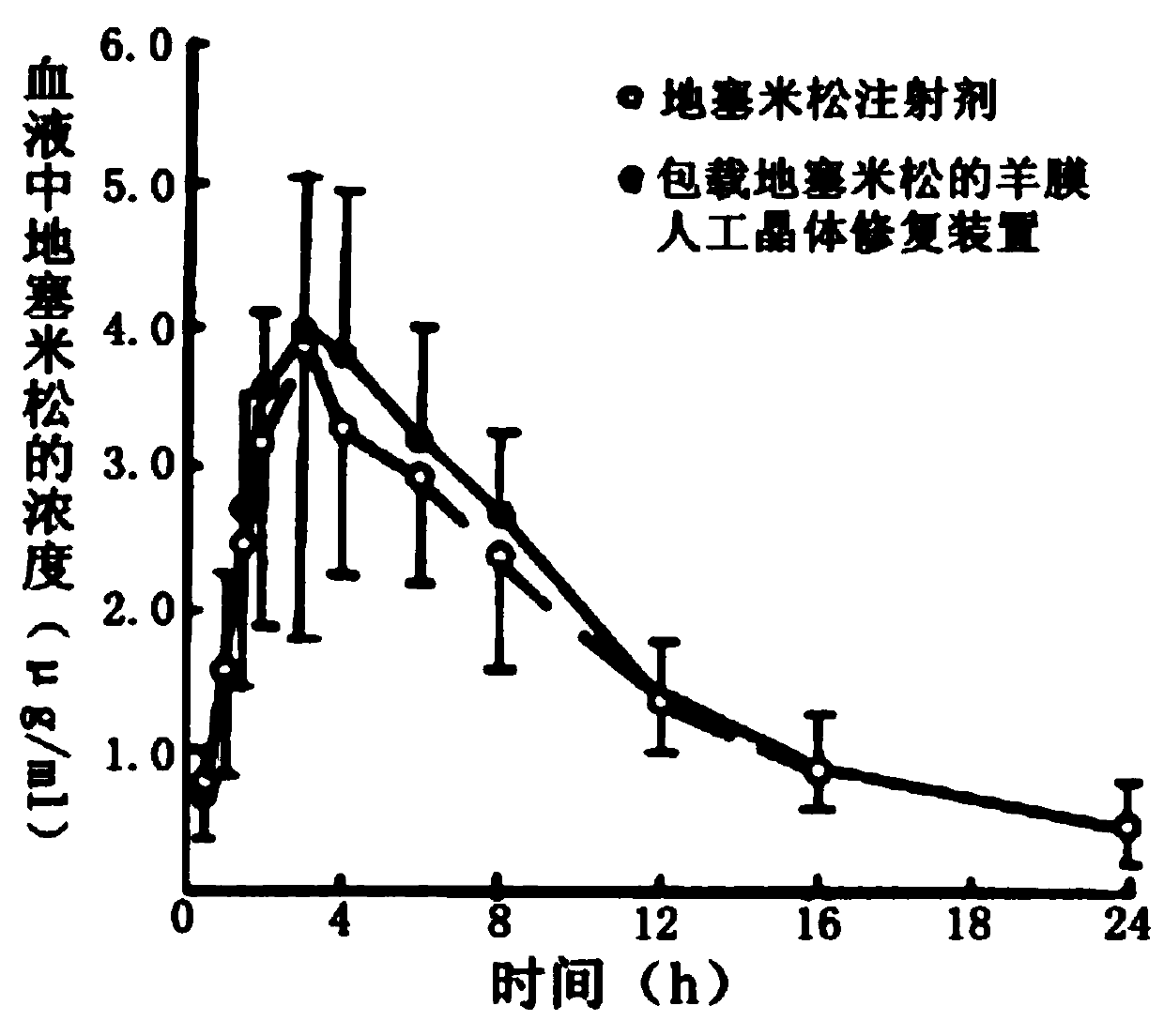Amnion contact lens, preparation method and application
A contact lens and amniotic membrane technology, applied in the field of medicine, can solve the problems of easy damage to amniotic membrane and cornea, scarring of corneal tissue, insufficient drug loading, etc.
- Summary
- Abstract
- Description
- Claims
- Application Information
AI Technical Summary
Problems solved by technology
Method used
Image
Examples
Embodiment 1
[0052] Step 101, adding the aqueous solution A containing dextran, trehalose and gelatin to the aqueous solution B containing polyethylene glycol to form a fibril network, and adding a concentration of 0.5 wt% to 1.0 wt% in the fibril network Wt% egg white lysozyme is reacted at the first set temperature and the first set speed for 10h to 12h to obtain the first water micro-droplet;
[0053] Step 102, dissolving the first water micro-droplet with a mass of 20mg-25mg and the slow-release drug with a mass of 0.5mg-1.0mg in an aqueous solution C with a volume of 8ml-10ml according to a mass ratio of 25:1 , reacting at the second set temperature and the second set speed for 4h to 6h to obtain the second water droplets;
[0054] Step 103, soak the placenta in amniotic membrane preservation solution containing gentamicin, streptomycin, penicillin and normal saline for 30 minutes, separate the chorion of the placenta after washing, and tile the upper surface of the separated placenta...
Embodiment 2
[0077] Step 201, adding 1.5wt%, 0.5wt%, and 0.5wt% dextran, trehalose and gelatin solutions to a 6.5wt% polyethylene glycol solution to form a fibril network , and then add 1wt% egg white lysozyme, and react for 10 hours at a temperature of 60° C. with a rotation speed of 100 rpm, thereby forming first water droplets with a diameter of 5 nm.
[0078] Step 202, dissolving 25 mg of the first water micro-droplet and sustained-release drug in a mass ratio of 25:1 in 10 ml of an aqueous solution, reacting for 5 hours at a temperature of 4°C and a rotation speed of 250 rpm, and finally The second water micro-droplets are obtained.
[0079] Step 203, soak the placenta with amniotic membrane preservation solution containing penicillin, streptomycin, penicillin and normal saline for 30 minutes, wash several times until the blood stains on the placenta are washed away, then bluntly separate the amniotic membrane from the chorion of the placenta, and put on Spread the surface on the sur...
Embodiment 3
[0086] Step 301 Preparation of the first water micro-droplets: adding dextran, trehalose, and gelatin with mass percent concentrations of 1.0wt%, 0.1wt%, and 0.1wt% respectively to polyethylene glycol containing 5.5wt% mass percent concentration A fibril network is formed in a solution of diol, and then a percentage concentration of 0.5 wt% egg white lysozyme is added, and the temperature is 65° C. and the rotation speed is 200 rpm, and the reaction is carried out for 12 hours, and the first fiber with a diameter of 5 nm can be prepared. Water water micro-droplets.
[0087] In order to further illustrate that the contact lens and the amnion in the amniotic contact lens provided by the embodiments of the present invention have good adhesion, preferably, the contact lens prepared by Example 1 or Example 2 and the entrapped The amniotic membrane of the second water micro-droplet is soaked in the 24-well plate containing the first water micro-droplet provided in Example 3, after s...
PUM
 Login to View More
Login to View More Abstract
Description
Claims
Application Information
 Login to View More
Login to View More - R&D Engineer
- R&D Manager
- IP Professional
- Industry Leading Data Capabilities
- Powerful AI technology
- Patent DNA Extraction
Browse by: Latest US Patents, China's latest patents, Technical Efficacy Thesaurus, Application Domain, Technology Topic, Popular Technical Reports.
© 2024 PatSnap. All rights reserved.Legal|Privacy policy|Modern Slavery Act Transparency Statement|Sitemap|About US| Contact US: help@patsnap.com










